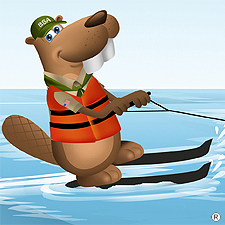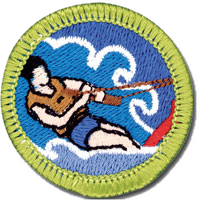Water Sports


Resources
- Water Sports Merit Badge Pamphlet
- Water Sports Merit Badge Workbook
- Scoutmaster Bucky's Merit Badge Advancement Quick Reference
Water Sports Requirements
Current Scouts BSA requirements
as of January 6, 2026
as of January 6, 2026
1.
Do the following:
a.
Explain to your counselor the most likely hazards you may encounter
while participating in water sports activities and what you should do
to anticipate, help prevent, mitigate, and respond to these hazards.
b.
Review prevention, symptoms, and first-aid treatment for the following
injuries or illnesses that could occur while participating in water
sports: blisters, cold-water shock and hypothermia, dehydration,
heat-related illnesses, sunburn, sprains, strains, minor cuts and
bruises, spinal injury, and concussions and head trauma.
c.
Review the Scouting America Safety Afloat policy. Tell how it applies
to water sports.
2.
Do the following:
a.
Discuss with your counselor the characteristics of life jackets most
appropriate for water sports, and tell why one must always be worn
while waterskiing or wakeboarding. Then demonstrate how to select and
fit a life jacket for water sports activities.
b.
Review and discuss the Water Sports Safety Code with your counselor.
Promise that you will live up to it and follow it in all water work for
this merit badge. Review the safety precautions that must be used by
the boat operator in pulling waterskiers and wakeboarders.
3.
Before doing requirements 4 through 6, successfully complete the Scouting
America swimmer test.
Note: See the Swimming merit badge pamphlet for details about the
Scouting America swimmer test.
4.
Show the following skier signals to the safety observer in the boat: skier
safe, faster, slower, turns, back to dock, cut motor, skier in water.
5.
Showing reasonable control while using two skis, one ski, or a wakeboard,
do the following:
a.
Show how to enter the water from a boat and make a deepwater start
without help.
b.
Starting from outside the wakes, show you can cross both wakes four
times and return to the center of the wake each time, without falling.
c.
Show you can fall properly to avoid an obstacle. Also show that you can
drop handle and coast to a stop without losing your balance.
6.
While on shore, show that you know how to properly adjust the bindings of
your ski(s) or wakeboard to fit yourself. Then, in deep water, show you can
adjust bindings to fit. Recover and put on your ski(s) or wakeboard that
has come off during a fall.